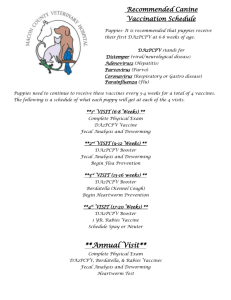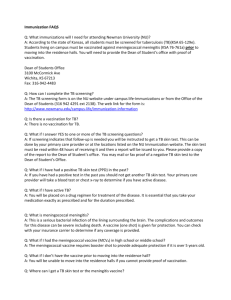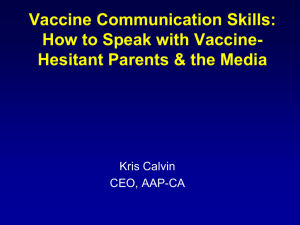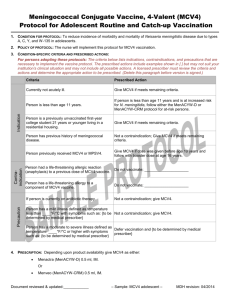Meningococcal Connjugate Vaccine (MCV4
advertisement
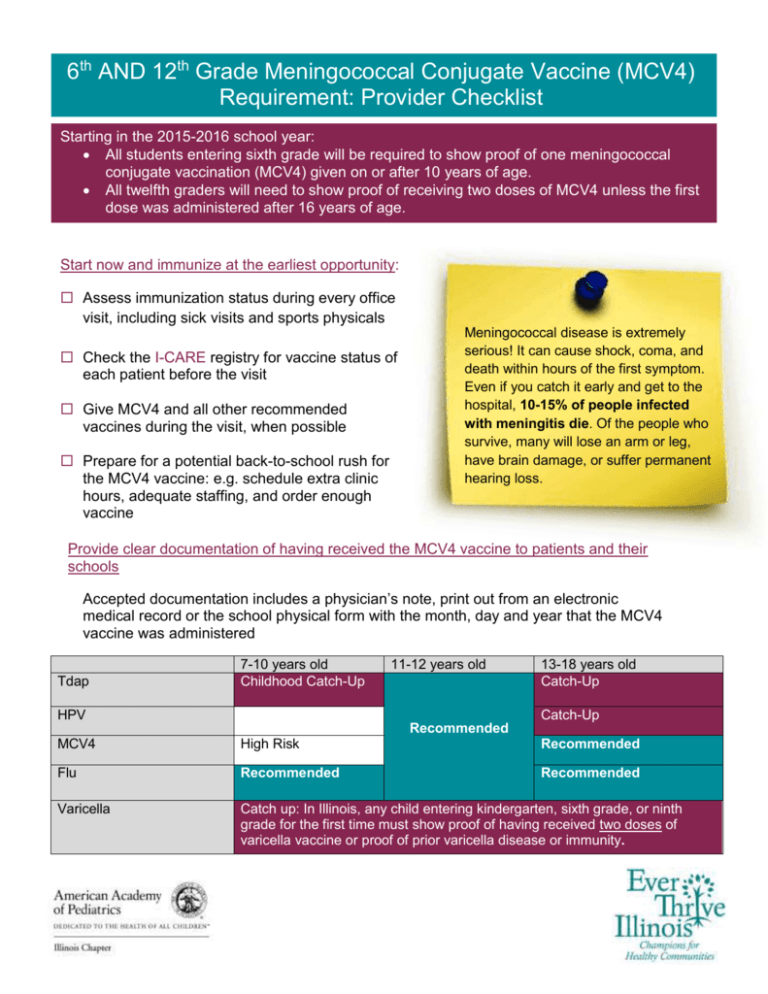
6th AND 12th Grade Meningococcal Conjugate Vaccine (MCV4) Requirement: Provider Checklist Starting in the 2015-2016 school year: All students entering sixth grade will be required to show proof of one meningococcal conjugate vaccination (MCV4) given on or after 10 years of age. All twelfth graders will need to show proof of receiving two doses of MCV4 unless the first dose was administered after 16 years of age. Start now and immunize at the earliest opportunity: Assess immunization status during every office visit, including sick visits and sports physicals Check the I-CARE registry for vaccine status of each patient before the visit Give MCV4 and all other recommended vaccines during the visit, when possible Prepare for a potential back-to-school rush for the MCV4 vaccine: e.g. schedule extra clinic hours, adequate staffing, and order enough vaccine Meningococcal disease is extremely serious! It can cause shock, coma, and death within hours of the first symptom. Even if you catch it early and get to the hospital, 10-15% of people infected with meningitis die. Of the people who survive, many will lose an arm or leg, have brain damage, or suffer permanent hearing loss. Provide clear documentation of having received the MCV4 vaccine to patients and their schools Accepted documentation includes a physician’s note, print out from an electronic medical record or the school physical form with the month, day and year that the MCV4 vaccine was administered Tdap 7-10 years old Childhood Catch-Up 11-12 years old HPV 13-18 years old Catch-Up Catch-Up Recommended MCV4 High Risk Recommended Flu Recommended Recommended Varicella Catch up: In Illinois, any child entering kindergarten, sixth grade, or ninth grade for the first time must show proof of having received two doses of varicella vaccine or proof of prior varicella disease or immunity. Strongly recommend vaccines! Your patients trust and respect your professional recommendation. They look to you to guide them as they make important decisions about their health. Use posters and charts around your office as reminders and as conversation starters. Recommend all ACIP recommended vaccines even if they are not required. Make certain that all staff support and understand the importance of vaccination. Nurses, physician’s assistants, clerical staff, and all other staff play a key role maintaining high vaccination rates. Reduce financial barriers Participate in the Vaccines for Children (VFC) program, which provides low or no cost vaccines to eligible children birth though 18 years of age. For more information click here: http://illinoisaap.org/projects/immunizations/vfc/ Standing orders Standing orders are a great way to improve vaccination rates. More information can be found here: http://www.immunize.org/catg.d/p3066.pdf Provide multiple vaccines in a single visit It is safe and encouraged to administer multiple vaccines in one visit. Use separate injection sites to minimize discomfort to patients. Do not miss an opportunity to administer vaccines Adolescents do not visit the doctor as often as babies; therefore, take every opportunity to vaccinate- including well visits, sick visits, and sports physicals. Have respectful discussions Some parents may have concerns about vaccines. It is important to listen, answers questions, and respectfully discuss vaccines. Even if a parent refuses a vaccine at one appointment, continue to have the conversation at future appointments. Use reminder recall tools Reminder recall tools are a great way to improve immunization rates- especially with multidose vaccines such as HPV and MCV4. Use state registry I-CARE Patient shot records can be stored and accessed through the state immunization registry (ICARE). More information can be found here: http://www.dph.illinois.gov/topicsservices/prevention-wellness/immunization/icare or at 1-800-526-4372 Prepare for a potential back-to-school rush Only order the amount of vaccines that you will need. How many patients need to receive MCV4 and other routine vaccines? Place order early enough to avoid running out of vaccine. Vaccine orders require at least 2-3 weeks for delivery. Do not order too much vaccine, so the vaccine doses may be properly stored.




